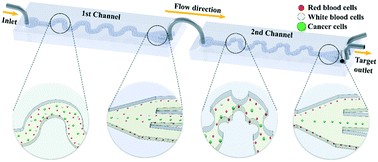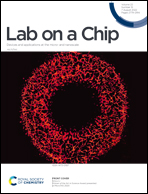Tuning particle inertial separation in sinusoidal channels by embedding periodic obstacle microstructures†
Abstract
Inertial microfluidics functions solely based on the fluid dynamics at relatively high flow speed. Thus, channel geometry is the critical design parameter that contributes to the performance of the device. Four basic channel geometries (i.e., straight, expansion-contraction, spiral and serpentine) have been proposed and extensively studied. To further enhance the performance, innovative channel design through combining two or more geometries is promising. This work explores embedding periodic concave and convex obstacle microstructures in sinusoidal channels and investigates their influence on particle inertial focusing and separation. The concave obstacles could significantly enhance the Dean flow and tune the flow range for particle inertial focusing and separation. Based on this finding, we propose a cascaded device by connecting two sinusoidal channels consecutively for rare cell separation. The concave obstacles are embedded in the second channel to adapt its operational flow rates and enable the functional operation of both channels. Polystyrene beads and breast cancer cells (T47D) spiking in the blood were respectively processed by the proposed device. The results indicate an outstanding separation performance, with 3 to 4 orders of magnitude enhancement in purity for samples with a primary cancer cells ratio of 0.01% and 0.001%, respectively. Embedding microstructures as obstacles brings more flexibility to the design of inertial microfluidic devices, offering a feasible new way to combine two or more serial processing units for high-performance separation.



 Please wait while we load your content...
Please wait while we load your content...